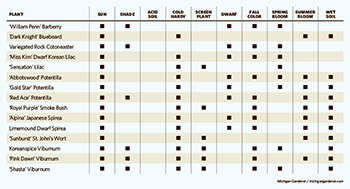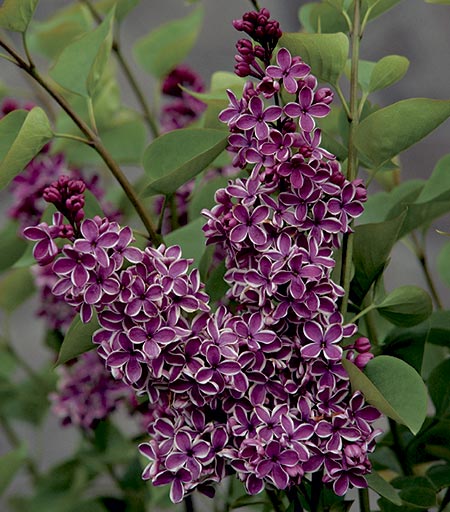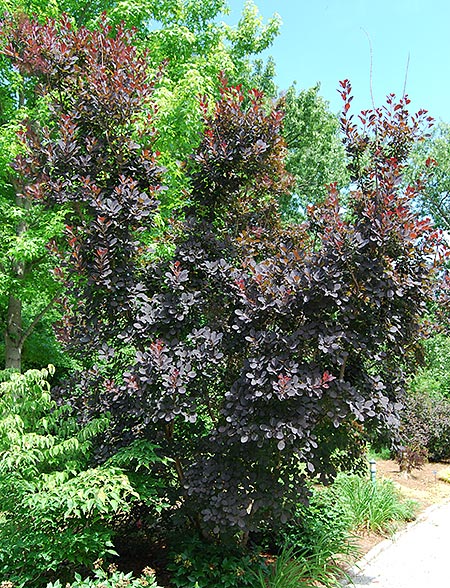by Keith Alexander
“April showers bring May flowers”—we’ve all praised the coming of spring with this cheerful rhyme. After the cold, dreary days of winter, it’s here… Spring! This is a great time to plant shrubs so they can begin to establish themselves before the long, hot days ahead. It is best to plant flowering shrubs before they leaf out in the spring. That said, with the proper care and watering, they can be planted at any time. I have put together a list of some of my favorite shrubs. By no means exhaustive, this list is a great starting point for some colorful ideas.
‘William Penn’ Barberry
This dwarf, dense, semi-evergreen plant (Berberis x gladwynensis ‘William Penn’) will grow 4 feet tall and 4 feet wide over 5 or 6 years. In May, tiny, bright yellow flowers will cover the waxy bronze-green foliage that looks much like holly. In the fall, these 1- to 2-inch narrow leaves turn a beautiful bronze color and remain on until spring. In a mild winter, this zone 5/6 plant will bounce right back to bright green. If the winter was a tough one, sometimes the branches that were above the snow may die back to the snowline or the center of the plant. Though this barberry is sometimes hard to find in garden centers, it’s worth looking for. Remember to plant it in a sunny location out of the west winter wind. This plant will do well in almost any well-drained location.
‘Dark Knight’ Bluebeard
This summer-flowering shrub (Caryopteris x clandonensis ’Dark Knight’) enjoys a sunny location in almost any type of soil. Rich green foliage gives way to beautiful purple/blue flowers that begin in June and continue for almost a month. A compact bluebeard, it only grows to 2 or 3 feet tall. It is best to cut this deciduous shrub to the ground each spring for maximum beauty, form and flower. It is resistant to most pests and disease.
Variegated Rock Cotoneaster
This slow, diminutive garden plant (Cotoneaster horizontalis `Variegatus’) is a graceful addition to any landscape, particularly a small space or rock garden. Its tiny, 1/4-inch white and green leaves turn burgundy before dropping each fall. A delicate coating of tiny pink blooms turn into shiny red fruits in late summer. Grows in a partial shade to sun location. This colorful character grows to 24 inches in 5 to 6 years.
‘Miss Kim’ Dwarf Korean Lilac
This compact-growing lilac (Syringa patula ‘Miss Kim’) gets only 3 or 4 feet tall. A reliable lavender bloomer each May, this fragrant lilac needs a well-drained sunny location for best performance. Sometimes found as a dwarf tree or top-grafted form, this lilac makes an excellent accent feature. It has beautiful medium-sized leaves that turn to a burgundy tint in the fall.
‘Sensation’ Lilac
One of the most outstanding lilacs available, this French hybrid form (Syringa vulgaris ‘Sensation’) boasts showy purple/red florets edged in white each spring. An upright grower, following the tradition of most other French lilacs, it can grow up to 10 or 12 feet tall. This fragrant lilac should be used in a sunny location where it has room to grow.
‘Abbotswood’ Potentilla
The group of plants that include potentilla is a large one, and this can make choosing the right potentilla a difficult task. ‘Abbotswood’ (Potentilla fruticosa ’Abbotswood’) is one of the best white-flowering forms of potentilla. It grows 2 to 3 feet high, with delicate blue-green leaves. A generous covering of white blooms decorate this dense shrub each spring. If the plant is pruned after it blooms in spring, a second crop of blooms will be your reward. This hardy shrub looks for a sunny location in any type of soil or exposure.
‘Gold Star’ Potentilla
Of the yellow potentillas, this one (Potentilla fruticosa ’Gold Star’) has a lower habit and larger, showy yellow blooms than most. Its growth should stay under 24 inches. Yellow flowers 2 inches wide will cover the plant throughout the summer if the spent blooms are pruned off. Once again, a sunny location is best for this and all other potentillas.
‘Red Ace’ Potentilla
Growing in a dense mound to 30 inches, this summer bloomer (Potentilla fruticosa ’Red Ace’) is coated with unique flame red, 1-inch flowers that are pale yellow on the undersides of the petals. This re-bloomer will change flower color from flame red to yellow based the intensity of the heat and moisture conditions surrounding this zone 3 hardy grower.
‘Royal Purple’ Smoke Bush
This large shrub (Cotinus coggygria ’Royal Purple’) grows to 15 feet tall. Its intense purple leaves are nearly 4 inches across. A delicate frosting of yellow blooms covers this plant during early summer, giving way to pink/purple seed heads. These long-lasting airy clusters cover the tree for weeks, giving the impression of a cloud of smoke. Plant this fast grower in a sunny location that allows for room to spread. Best planted in well-drained soil out of direct winter winds.
‘Alpina’ Japanese Spirea
A very dense mounding shrub (Spiraea japonica ‘Alpina’), this zone 4 summer bloomer makes a great accent plant in today’s modern, low maintenance landscape. Delicate pink clusters of bloom will cover this plant all summer long. Although there are many different spireas to choose from, this one rates high as one of the best dwarf, green-leafed forms. Almost any sunny location will be great for this 18-inch tall plant.
Limemound Dwarf Spirea
This brightly-colored, mounding plant (Spirea x bumalda Limemound) makes a dramatic accent plant for any landscape. A good choice for massing, this 24-inch tall plant has delicate pink blooms on and off all summer long. The most dramatic color comes from its orange and lemon-yellow leaves in spring that turn to lime-green throughout the summer. It finishes out the season with beautiful auburn-red foliage in the fall. Hardy to zone 3, this sun-loving plant will tolerate almost any type of location.
‘Sunburst’ St. John’s Wort
This upright hardy shrub (Hypericum frondosum ’Sunburst’) makes a great border, accent, or hedge plant. Its dense habit, and dense blue-green 1/2-inch leaves make an excellent background for the profuse yellow blooms that cover the plant throughout the summer. A zone 4 rating makes this one a hardy choice for almost any sunny location.
Koreanspice Viburnum
A medium grower to 6 feet, this viburnum (Viburnum carlesii) is one of the most fragrant available. Leathery green, 3-inch leaves are soon followed by 4- to 5-inch snowballs of pink/white fragrant blooms each spring. Following the blooms, small red fruits hold on until they turn black in the fall. These black berries are highly desired by the most discriminating of our feathered friends. This classic plant will do well in partial shade or full sun, and is hardy in almost any location.

‘Pink Dawn’ Viburnum
Large, dark green foliage covers this upright grower (Viburnum x bodnantense ‘Pink Dawn’) to 8 or 10 feet. Very unique rose-colored blooms may open as early as February if the weather is mild. Its blooms are fragrant and hardy. Small, dark blue fruits will form in late spring. These small unobtrusive fruits make great attractions for the birds.
‘Shasta’ Viburnum
‘Shasta’ (Viburnum plicatum f. tomentosum ‘Shasta’) is an improvement on the traditional Japanese snowball viburnum. It has a compact habit that grows only to 6 or 8 feet. Showy white blooms coat the horizontal arching limbs, creating a dramatic effect in May. Its large, 5-inch leathery green leaves turn to a reddish purple color in the fall. The red fruits turn to black before the birds begin to feed. ‘Shasta’ makes a great border or screening plant in almost any type of location from medium shade to full sun.


